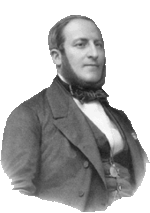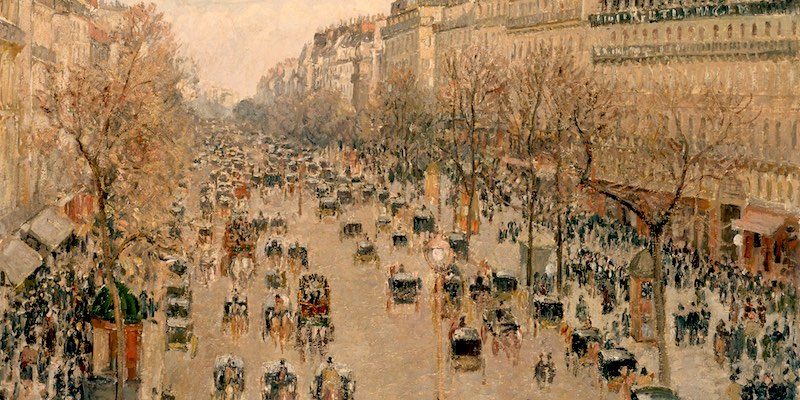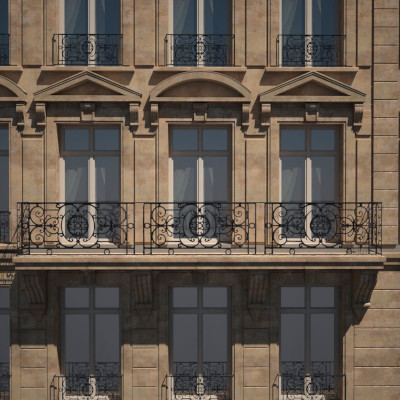David P. Jordan, "Haussmann and Haussmannisation:
The Legacy for Paris."
French Historical Studies, Vol. 27, No. 1 (Winter 2004), pp. 87-92.
When
Georges-Eugène Haussmann died (10 January 1891) he had been so
long absent from public life that there was no recent picture to accompany his
obituary. L’illustration doctored an old photograph, deepening
the lines around eyes and mouth, taking some flesh off his
cheeks, removing most of his hair, and changing his coat and
cravat. The now melancholy, tired countenance of a vanished
supremacy gazes sadly out at us.1
public life that there was no recent picture to accompany his
obituary. L’illustration doctored an old photograph, deepening
the lines around eyes and mouth, taking some flesh off his
cheeks, removing most of his hair, and changing his coat and
cravat. The now melancholy, tired countenance of a vanished
supremacy gazes sadly out at us.1He had fallen from power more than twenty years earlier, reluctantly sacrificed by Napoléon III, who no more understood the financial legerdemain that brought his prefect down than did most of those closing in for the kill. Few regretted the departure of this harsh, arrogant, humorless, and utterly efficient administrator. His reputation was soon completely ruined by the debacle of Sedan, which engulfed the Second Empire in vituperation. But of all the significant figures of the age Haussmann created work that endured longer, even aged gracefully, and entered into the consciousness of the French in ways impossible to measure. The plan and to some extent the vision of Paris that all who live there or have spent time in residence there carry in their minds is the city he made. There is a nice irony in the fact that the Boulevard Haussmann—there was a rancorous debate in the Chamber of Deputies about thus honoring him—was the only major street cut, or rather completed, between 1920 and 1940.2 The city’s debt for his massive urban renewal was retired only in 1929.  Urban patterns persist, sometimes through centuries, and bind
future generations. . . Haussmann’s work on Paris, I here argue,
is similar. He fixed the shape, the itineraries, the
architecture, and in part the culture of Paris in ways that have
shown surprising vitality for more than a century. His
successors have added onto his work without obliterating it.
Even those who loathe Haussmann’s urban ideas and influence have
found themselves enmeshed in his net. The Third Republic
embraced and continued his work, despite official denials. The
most radical proposals for transforming Paris anew, those of Le
Corbusier, were in fact haussmannisme raised to another level.
Throughout the twentieth century small but significant efforts
were made to escape his conceptualization of the city,
culminating in the De Gaulle and Pompidou years, when a new
Paris lifted skyward. At ground level Haussmann’s streets
endured, and so too did public attachment to his city under
attack. . . .
Urban patterns persist, sometimes through centuries, and bind
future generations. . . Haussmann’s work on Paris, I here argue,
is similar. He fixed the shape, the itineraries, the
architecture, and in part the culture of Paris in ways that have
shown surprising vitality for more than a century. His
successors have added onto his work without obliterating it.
Even those who loathe Haussmann’s urban ideas and influence have
found themselves enmeshed in his net. The Third Republic
embraced and continued his work, despite official denials. The
most radical proposals for transforming Paris anew, those of Le
Corbusier, were in fact haussmannisme raised to another level.
Throughout the twentieth century small but significant efforts
were made to escape his conceptualization of the city,
culminating in the De Gaulle and Pompidou years, when a new
Paris lifted skyward. At ground level Haussmann’s streets
endured, and so too did public attachment to his city under
attack. . . .The uniform look of the new city was created as much by the buildings lining the new, obsessively  straight streets as by the streets themselves. The striking
regularity of the typical Haussmann building—in the Beaux-Arts
manner, its height fixed by decree depending on the width of the
street, with balconies (their depth regulated) and ornamental
ironwork—was achieved with surprisingly vague general
regulations. On the Boulevard Saint-Germain, for example,
‘‘owners and their neighbors should arrange between themselves
to have, in each construction îlot, the same height for each
floor in order to continue the principal lines of the façades
and to make the entire îlot a single architectural ensemble.’’
The architects of the day shared a common vocabulary and needed
no additional coercion to produce a homogeneous cityscape.
straight streets as by the streets themselves. The striking
regularity of the typical Haussmann building—in the Beaux-Arts
manner, its height fixed by decree depending on the width of the
street, with balconies (their depth regulated) and ornamental
ironwork—was achieved with surprisingly vague general
regulations. On the Boulevard Saint-Germain, for example,
‘‘owners and their neighbors should arrange between themselves
to have, in each construction îlot, the same height for each
floor in order to continue the principal lines of the façades
and to make the entire îlot a single architectural ensemble.’’
The architects of the day shared a common vocabulary and needed
no additional coercion to produce a homogeneous cityscape.Haussmann underlined the severe rectilinearity of the transformed city by planting rows of chestnut trees and, in the center of Paris, where the urban fabric was closely woven and he had little room to maneuver, by improvising, sometimes brilliantly, sometimes clumsily, to keep his neoclassical aesthetics intact. He created optical illusions by moving monuments (or building new ones) and occasionally erected an eccentric new building or monument to fill an irregular urban space or to complete a geometric pattern. Haussmann’s percées [the process of cutting through existing blocks of buildings]imposed an enduring template on Paris and on an urban logic worked out in the quarter century after his fall. Paris was seen as the quintessential modern city at the end of the nineteenth century not because its buildings were technically advanced (mostly they were not), or because new patterns of urbanization had been developed (Haussmann’s ideas were traditional, neoclassical), or because Haussmann brought new levels of comfort to urban living (quite the contrary). His most unconventional and innovative ideas—moving the cemeteries out of the city, for example—were rejected. It was the newstreets, especially the boulevards, that were universally admired. Haussmann’s shortcomings as a city maker were perpetuated by virtually all the successive governments through the Third and Fourth Republics, indeed well into the 1960s. The scope of his transformations was enormous. . . There were attempts to break the mold, many originating with young architects who felt muzzled by the inherited conventions. But the building codes and regulations, although precise and restrictive about ornamentation, were not crippling, and there was no widespread call for change until nearly the end of the century. Clients, always the bane of architects, were content. The building style developed in the 1850s and 1860s, fixed in city regulations and given the imprimatur of the Beaux-Arts curriculum and atelier system associated with good taste, modernity, and wealth, became the style of choice for those able to invest in the new city. Familiar façades, building materials, and predictable ornamentation proclaimed the social standing of the occupants. The ‘‘type haussmannien d’immeuble’’ [ the Haussmannian type of building] had become the very essence of a public building. |